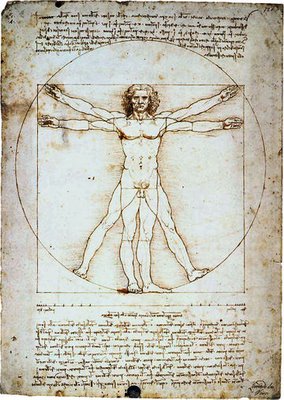
The Vitruvian Man is a famous drawing with accompanying notes by Leonardo da Vinci made around the year 1492 in one of his journals.
It depicts a naked male figure in two superimposed positions with his arms and legs apart and simultaneously inscribed in a circle and square. The drawing and text are sometimes called the Canon of Proportions or, less often, Proportions of Man. It is on display in the Gallerie dell' Accademia in Venice, Italy.
Vitruvius, the architect, says in his work on architecture that the measurements of the human body are as follows that is that 4 fingers made 1 palm, and 4 palms make 1 foot, 6 palms make 1 cubit; 4 cubits make a man's height.
And 4 cubits make one pace and 24 palms make a man. The length of a man’s outspread arms is equal to his height. From the roots of his hair to the bottom of his chin is the tenth of a man’s height; from the bottom of the chin to the top of the head is one eighth of his height; from the top of the breast to the roots of the hair will be the seventh part of the whole man.
From the nipples to the top of the head will be the fourth part of man. The greatest width of the shoulders contains in itself the fourth part of man.
From the elbow to the tip of the hand will be the fifth part of a man; and from the elbow to the angle of the armpit will be the eighth part of man.
The whole hand will be the tenth part of the man. The distance from the bottom of the chin to the nose and from the roots of the hair to the eyebrows is, in each case the same, and like the ear, a third of the face.
See the Code
Related (1)(2)
No comments:
Post a Comment